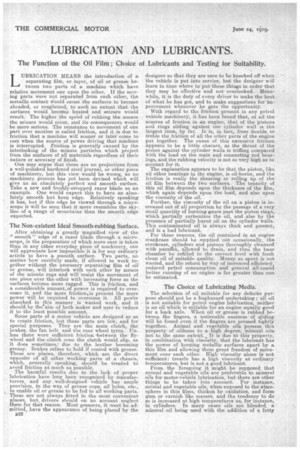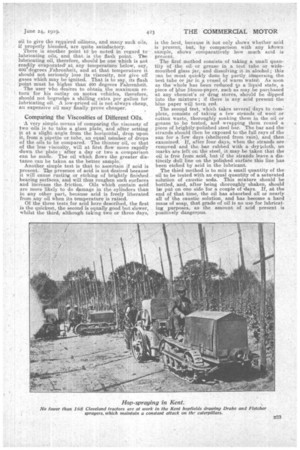• LUBRICATION AND LUBRICANTS.
Page 38

Page 39

If you've noticed an error in this article please click here to report it so we can fix it.
The Function of the Oil Film ; Choice of _Lubricants and Testing for Suitability.
LUBRICATION MEANS the introduction of a separating film, or layer, of oil or grease between two parts .of a machine which have relative movement one upon the other. If the moving parts were not separated from each other, the metallic contact Would cause the surfaces to become abraded, or roughened, to such an extent that the surfaces would become heated and seizure would result. The higher the speed of rubbing the sooner the seizure would occur, and its consequences would be more serious. The resistance to movement of one part over another is called friction, and it is due to friction that a machine will sooner or later come to rest when the source of power driving that machine is interrupted. Friction is generally caused by the interlocking of the minute particles which project from the surfaces of all materials regardless of their nature or accuracy of finish.
One may argue that there are no projections from a well-polished hardened steer journal, or other piece of machinery, but this view would be wrong, as no machinery process has yet been devised which will give us an absolutely perfect and smooth surface. Take a new and freshly-stropped razor blade as an example. One would expect this to have an absolutely smooth but keen edge. Relatively speaking it has, but if this edge be viewed through a microscope it will be seen that it more resembles the skyline of a range of mountains than the smooth edge expected.
The Non-existent Ideal Smooth-rubbing Surface.
After obtaining a greatly magnified view of the "smooth " edge of a razor blade through a microscope, in the preparation of which more care is taken than in any other everyday piece of machinery, one will appreciate how impossible it is for any ordinary article to have a, smooth surface. Two parts, no matter how carefully made, if allowed to work together without the necessary separating film of oil or grease, will interlock with each other by means of the minute rags and will 'resist the movement of one piece over the other with increasing force as the surfaces become more ragged. This is friction, and a considerable amount, of power is required to overcome it, and the more friction,is present the more power will be required to overcome it. All power absorbed in this manner is wasted work, and it should he the*airn of both maker and user to reduce it to the least possible amount.
Some parts of a motor vehicle are designed so as to create friction, but these. parts are few, and for special purposes. They are the. main clutch, the brakes, the fan belt, and the rear wheel tyres. Unless there were sufficient friction kletween the flywheel and the clutch cone the clutch would slip, as it does sometimes,due to the leather, becoming greasy. Brakes refuse to hold if coated with grease. These are places, therefore, which are the direct opposite of all other working parts of a, chassis, which, generally speaking, should be treated to avoid friction as much as possible. The harmful results due to the lack of proper lubrication have long been recognized by manufacturers, and any well-designed vehicle has ample provision, in the way of grease cups, oil holes, etc., to enable oil or grease to be fed to all working parts. These are not always fitted in the most convenient places. but, drivers should on no account neglect them for that reason. Most greasers, it must be admitted, have the appearance of being placed by the B32 designer so that they are sure to be knocked off when the vehicle is put into service, but the designer will learn in time where to put-these things in order that they may be effective and not overlooked. Meanwhile, it is the duty of every driver to make the best of what he has got, and to make suggestions for improvement whenever he gets the opportunity.
With regard to the friction present in any petrol vehicle machinery, it has been found that, of all the sources of friction in, an engine, that of the pistons and rings sliding against the cylinder wall is the largest item? by far. It is, in fact, from double to treble the friction of all the other parts of the engine put together. The cause or this excessive friction appears to be a little obscure, as the thrust of the piston against the cylinder wails is trifling compared with the load on the main and connecting rod bearings, and the rubbing velocity is not so very high as to account for it.
The explanation appears to be that the piston, like, all other bearings in the engine, is oil-borne, and the friction. is really the shearing or rolling •up of the oil film between the two surfaces. The tenacity of this oil film depends upon the thickness of the film, which again depends upon the load, and also upon the viscosity of the oil.
Further, the viscosity of the oil on a piston is increased out of all proportion by the passage of a very small quantity of burning gases past the piston rings, Which partially carbonizes the oil, and also by the presence of partially burnt oil on the cylinder walls. This contaminated oil is always thick and gummy, and is a bad lubricant.
For these reasons, the oil eontained in an engine crankcase should be emptied out occasionally, the crankcase, cylinders and pistons thoroughly cleansed' with paraffin, allowed to drain, and then the base chamber be refilled to the correct level with fresh . clean oil of suitable quality. Money so spent is not wasted, and the return by way of increased efficien4, reduced petrol consumption and general all-round better running of an engine is far greater than can be estimated.
The Choice of Lubricating Media.
The selection of oil suitable for any definite purpose should not be a haphazard undertaking; all oil is not suitable for petrol 'engine lubrication, neither is an oil which is suitable for an engine equally good for a back axle. When oil or grease is rubbed between the fingers, a noticeable easiness of sliding will be found even if the fingers are pressed tightly together. Animal and vegetable oils possess this property of oiliness to a high degree, mineral oils not to the same extent..„It is due to this property, in combination with viscosity, that the lubricant has the power of keeping metallic surfaces apart by a thin film and allowing them great freedom of movement over each other. High viscosity alone is not eufficient: treacle has a, high viscosity at ordinary temperatures, but is not a good lubricant.
From the foregoing it might be supposed that animal and vegetable oils are preferable to mineral oils for motor-vehicle lubrication, but there are other things to be taken into account: For instance, animal and vegetable oils, When exposed to the atmosphere in thin films, thicken by oxidation, and form gum or varnish like masses, and the tendency to do so is increased at high temperatures as, for instance, in cylinders. In many cases this are blended, a mineral oil being used with the addition of a fatty, oil to give the required oiliness, and many such oils, if properly blended, are quite satisfactory. There is another point '03 be noted in regard to lubricating oils, and that is the flash 'point. Tire lubricating oil, therefore, should be one which is not readily evaporated" at any temperature below, say, 400'degrees Fahrenheit, and at that temperature it should not seriously lose its viscosity, nor give off gases which may be ignited. That is to say, its flash point must be higher than 400 degrees Fahrenheit. The user who desires to obtain the maximum return for his outlay on motor vehicles, therefore, should not begrudge a shilling extra per gallon for lubricating oil. A low-priced oil is not always cheap, an expensive oil may finally prove cheaper.
Comparing the Viscosities of Different Oils.
'A very simple means 'of comparing the viscosity of two oils is to take a glass plate, and after setting , it at a slight angle from the horizontal, drop upon it, from a pipette or tube, an equal uninber of drops of the oils to be compared. The thinner oil, or that of the less viscosity, will at first flow more rapidly down the plate ; after a day or two a comparison can be made. The oil which flows thn greater distance can be taken as the better sample. Another simple test is that to ascertain if acid is present. The presence of acid is not desired because it will cause rusting or etching of brightly finished bearing surfaces, and will thus roughen such surfaces and indease the friction. Oils which contain acid are more likely to do damage in the cylinders than in any other part, because acid is freely liberated from any oil When its temperature is raised.
Of the three tests for acid here described, the first is the quickest, the second is equally good but slower, whilst the third, although taking two or three days,
is the best, because it not only shows whether acid is present; but; by comparison with any kitown sample, shows cOmparatively how much acid is present.
The first method consists of taking a small quantity of the oil or grease in a test tube or widemouthed glass jar, and dissolving it in alcohol; this an be most quickly done by partly ithmersing the test tube or jar in a -vessel of warm water: As soon as the whole has been reduced to a liquid state, a piece. of blue litmus-paper, such as may be purchased at any chemist's or drug stores, sliniuld be dipped into the mixture ; if there is any acid present the: blue paper witl turn red.
The second test, which takes several days to complete, consists of taking a few strands of wool or cotton waste, thoroughly soaking them in the oil or grease to be tested, and wrapping them round a piece of brightly-polished steel bar. The bar and the strands should then be exposed to the full rays of the sun for a few days (sheltered from rain), and then examined. If, after four days, when the strands are removed and the bar rubbed with a drykcloth, no marks are left on the steel, it may be taken that the oil is free from acid, but if the strands leave a distinctly dull line on the polished surface this line has been etched by acid in the lubricant.
The third method is to mix a small quantity of the oil to be tested with an equal quantity of a saturated solution of caustic soda. This mixture should be bottled, and, after being thoroughly shaken, should be put on one side for a couple of days. If, at the end of that time, the oil has absorbed all or nearly all of the caustic solution, and has become a, hard mass of soap, that grade of oil is no use for lubricating purposes, as the amount of acid present is positively dangerous.










































